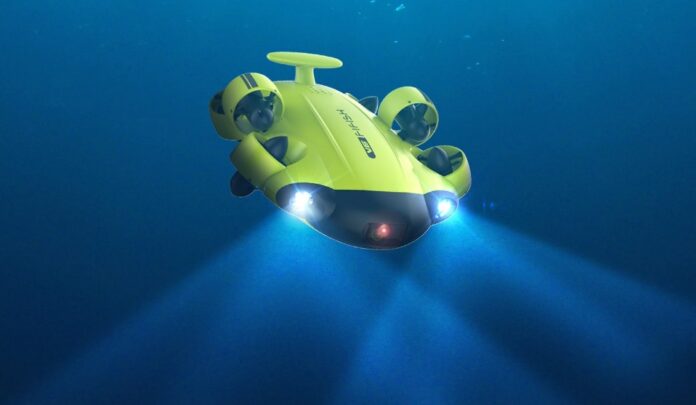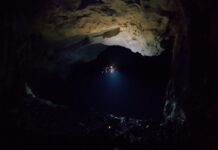
Ever since the first remotely operated underwater vehicle, POODLE, was first launched in 1953, underwater robots such Autonomous Underwater Vehicles (AUVs) and Remotely Operated Vehicles (ROVs) began to evolve through the 1960s and 1970s, mostly for military purposes.
In the 1980s, ROVs became available for use in the commercial offshore industry and began to emerge for scientific applications. The first tether-less, autonomous vehicles were built for experimental purposes in the 1970s.
Currently, underwater robots are increasingly used for military, commercial, and scientific applications, including deep-sea exploration for resources like oil, gas and metals, pipeline repair, shipwreck investigation, surveys, oceanographic sampling, underwater archaeology and under ice survey, and the understanding of natural forces such as hurricanes and tsunamis.
An underwater robot is an autonomous underwater vehicle (AUV) that can travel underwater without requiring input from an operator. AUVs are part of a larger group of undersea systems known as unmanned underwater vehicles, a classification that also includes non-autonomous remotely operated underwater vehicles (ROVs) – controlled and powered from the surface by an operator/pilot via an umbilical or using the remote control.
All ROVs are equipped with a video camera, propulsion system, and lights. Other equipment such as manipulator arm, water sampler, instruments that measure clarity, light penetration, temperature, and depth, is added depending on the specifications required. In military applications, AUVs are often referred to as unmanned undersea vehicles (UUVs).
Types of ROVs
Modern ROVs are categorized based on their size, depth capability, on-board horsepower, and whether they are all-electric or electro-hydraulic as follows:
- Micro – Micro class ROVs are very small in size and weight. They can weigh less than 3kg and are used as an alternative to a diver, specifically in places where a diver might not physically enter, such as a sewer, pipeline, or small cavity.
- Mini – Mini Class ROVs weigh around 15kg. They are also used as a diver alternative. A single person can transport the complete ROV system on a small boat, deploy it and complete the job without outside help.
- General – They typically have less than 5HP (propulsion), manipulators, grippers, and a sonar unit used on light survey applications. The maximum depth is less than 1,000 meters.
- Light Work class – They typically have less than 50HP (propulsion). They carry manipulators and are made from polymers such as polyethylene rather than conventional alloys. They have a maximum working depth of less than 2000 m.
- Heavy Work class – They typically have less than 220HP (propulsion) with the ability to carry at least two manipulators. They have a working depth of up to 3500 m.
- Trenching/Burial – They typically have more than 200hp (propulsion) and not usually greater than 500 HP with an ability to carry a cable laying sled and work at depths up to 6000 m in some cases.
The common types of sensors used in underwater vehicles are as follows:
- Compass (gyrocompass or magnetic) provides estimates of magnetic north.
- Inertial measurement unit (IMU) provides information about the vehicle’s linear acceleration and angular velocity.
- Depth sensor Measures the water pressure and depth.
- Altitude and forward-looking sonar detects the presence of obstacles and distance from the seafloor.
- Doppler velocity log (DVL) estimates of vehicle velocity relative to the seafloor and relative water motion
- Global positioning system (GPS) is a navigation system to locate the vehicle position.
- Acoustic positioning – determines the vehicle position using acoustics.
- Vision systems (cameras) performs tasks such as visual tracking of pipelines, station keeping, visual serving, or image mosaicking.
Applications of underwater robots
Underwater robots currently play prominent roles in several scientific, commercial, and military tasks. They are increasingly used to relieve the burden on human operators and to improve performance.
Presently, AUVs are used almost exclusively for survey work, but sampling and other intervention tasks are becoming more feasible. The goal is not only for these robotic vehicles to replace human divers or human-occupied vehicles but also to enable an entirely new generation of subsea equipment serviced without intervention by drillships or other heavy-lifting vessels.
The offshore oil and gas industry heavily relies on ROVs for installation, inspection, and servicing of platforms, pipelines, and subsea production facilities. As the search for oil and gas goes deeper, this trend can only continue. Scientific applications for ROVs include survey, inspection, and sampling tasks previously performed by human-occupied submersibles or towed vehicles. Scientific ROVs are now equipped with sophisticated sampling devices for sampling animals, microbes, caustic hydrothermal vent fluids, and various rock samples. Moreover, ROVs are also used to deploy and operate seafloor experiments, which can involve difficult tasks such as drilling and the delicate placement of instruments.
ROVs have also emerged as powerful tools for investigating underwater shipwrecks and other cultural sites. Applications include forensic investigations of modern shipwrecks to determine the cause of sinking, archaeology, and salvage. Specific mapping tasks include seafloor bathymetry, sonar imaging, magnetic field mapping, hydrothermal vent localization, and photo surveys.
AUVs can improve productivity and data quality compared to towed and tethered systems. They have also operated in environments where no other means of gathering data is possible, such as under ice shelves. Likewise, the increasing availability of sophisticated chemical sensors, biological sensors, and mass spectrometers now allows AUVs to build spatial and temporal maps of environmental features that could previously only be studied by bringing samples back to the laboratory.
The military has always been a leader in the development of underwater robotic capabilities. They pioneered ROVs for tasks such as recovering test weapons and deep-sea salvage.
Many countries operate AUVs for military surveys, gather environmental data, and search for hazards such as mines. The most innovative application includes networks of AUVs that can act as extensions of conventional surface vessels and submarines, enabling surveillance over wide areas for extended periods at costs far less than what could be achieved with conventional surface vessels, submarines, and aircraft.

















